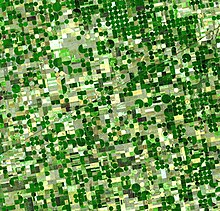Agricultural geography
This article includes a list of general references, but it lacks sufficient corresponding inline citations. (January 2014) |

Agricultural geography is a subdiscipline of human geography.
Focus
It is traditionally considered the branche of economic geography that investigates those parts of the Earth's surface that are transformed by humans through primary sector activities. It thus focuses on structures of agricultural landscapes and asks for the processes that lead to these spatial patterns. While most research in this area concentrates rather on production than on consumption,[1] a distinction can be made between nomothetic (e.g. distribution of spatial agricultural patterns and processes) and idiographic research (e.g. human-environment interaction and the shaping of agricultural landscapes). The latter approach of agricultural geography is often applied within regional geography.
See also
References
- ^ Laingen, C. & L. Butler Harrington (2013): Agricultural Geography. Oxford Bibliographies. Oxford University Press. DOI 10.1093/OBO/9780199874002-006
Literature
- Robinson, G.M. (2003): Geographies of Agriculture: Globalisation, Restructuring and Sustainability. Routledge. ISBN 978-0-582-35662-7
- Grigg, D. (1995): An Introduction to Agricultural Geography. Routledge. ISBN 978-0-415-08443-7
